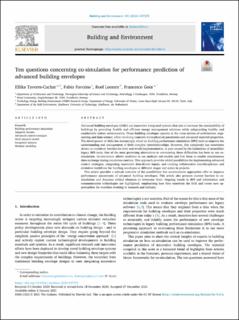| dc.contributor.author | Taveres-Cachat, Ellika | |
| dc.contributor.author | Favoino, Fabio | |
| dc.contributor.author | Loonen, Roel C.G.M | |
| dc.contributor.author | Goia, Francesco | |
| dc.date.accessioned | 2021-01-22T14:24:58Z | |
| dc.date.available | 2021-01-22T14:24:58Z | |
| dc.date.created | 2021-01-07T10:21:04Z | |
| dc.date.issued | 2020 | |
| dc.identifier.issn | 0360-1323 | |
| dc.identifier.uri | https://hdl.handle.net/11250/2724316 | |
| dc.description.abstract | Advanced building envelopes (ABEs) are innovative integrated systems that aim to increase the sustainability of buildings by providing flexible and efficient energy management solutions while safeguarding healthy and comfortable indoor environments. These building envelopes operate at the cross-section of architecture, engineering and data science, often involving transient multi-physical parameters and advanced material properties. The development of ABEs has increasingly relied on building performance simulation (BPS) tools to improve the understanding and management of their complex interrelationships. However, this complexity has sometimes shown to constitute barriers for their real-world implementation, in part caused by the limitations of monolithic legacy BPS tools. One of the most promising alternatives to overcoming these difficulties has been to use cosimulation. Co-simulation allows modelers to use multiple sub-models and link them to enable simultaneous data exchange during simulation runtime. This approach provides added possibilities for implementing advanced control strategies, integrating innovative data-driven inputs, and creating collaborative interdisciplinary and evolutive workflows for building envelopes at different stages and scales in projects. This article provides a critical overview of the possibilities that co-simulation approaches offer to improve performance assessments of advanced building envelopes. This article also presents current barriers to cosimulation and discusses critical elements to overcome them. Ongoing trends in BPS and information and communication technologies are highlighted, emphasizing how they transform the field and create new opportunities for modelers working in research and industry. | en_US |
| dc.language.iso | eng | en_US |
| dc.rights | CC BY 4.0 | * |
| dc.rights.uri | http://creativecommons.org/licenses/by/4.0/ | * |
| dc.subject | Building performance simulation | en_US |
| dc.subject | Adaptive facades | en_US |
| dc.subject | Advanced control strategies | en_US |
| dc.subject | Multi-physical model | en_US |
| dc.subject | Integrated analysis | en_US |
| dc.subject | Modular modeling | en_US |
| dc.title | Ten questions concerning co-simulation for performance prediction of advanced building envelopes | en_US |
| dc.type | Peer reviewed | en_US |
| dc.type | Journal article | en_US |
| dc.description.version | publishedVersion | en_US |
| dc.rights.holder | © 2020 The authors | |
| dc.subject.nsi | VDP::Teknologi: 500 | en_US |
| dc.source.volume | 191 | en_US |
| dc.source.journal | Building and Environment | en_US |
| dc.identifier.doi | 10.1016/j.buildenv.2020.107570 | |
| dc.identifier.cristin | 1866818 | |
| dc.relation.project | Norges forskningsråd: 262198 | en_US |
| dc.relation.project | Norges forskningsråd: 255252 | en_US |
| dc.source.articlenumber | 107570 | en_US |
| cristin.ispublished | false | |
| cristin.fulltext | original | |
| cristin.qualitycode | 2 | |

